
This page represents part 2 of the tour of the lower stained glass windows on the north or left side of the church. The brown rectangle, above, highlights the windows on this part of the summary tour.
To return to Part 1, Click here
N01
Paul Before Agrippa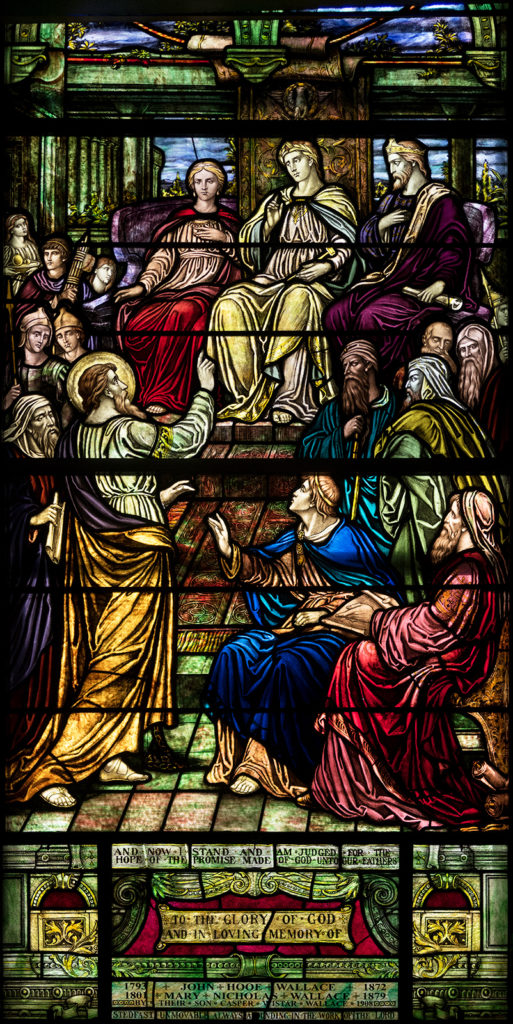
This window was given by Charles W. Wallace in honor of his parents, John and Mary Wallace. His four sons, Charles, Howson, Wellington, and Wistar became presidents of the National Bank of Fredericksburg just across the street as did two grandsons. Wellington also became a prominent judge.
Wellington’s wife Victoria gave many of our windows in 1908 and 1909. This window was made by Charles Hogeman in 1908. This window depicts a hearing of the argument of Paul on the resurrection of the dead, as told in Acts, chapters 25 and 26.
The picture itself represents Paul in chains before Festus, the prosecutor of Judea, on the right. Agrippa, a small-time king, is found in the middle. Bernice, the wife of the governor, is placed on the left. Paul’s accusers, guards, chief priests, and other people are pictured around him. Below we find the following quotation: “And now I stand and am judged for the hope of the promise made of God unto our fathers.”
More information on the Paul Before Agrippa window
N02
Jesus with Children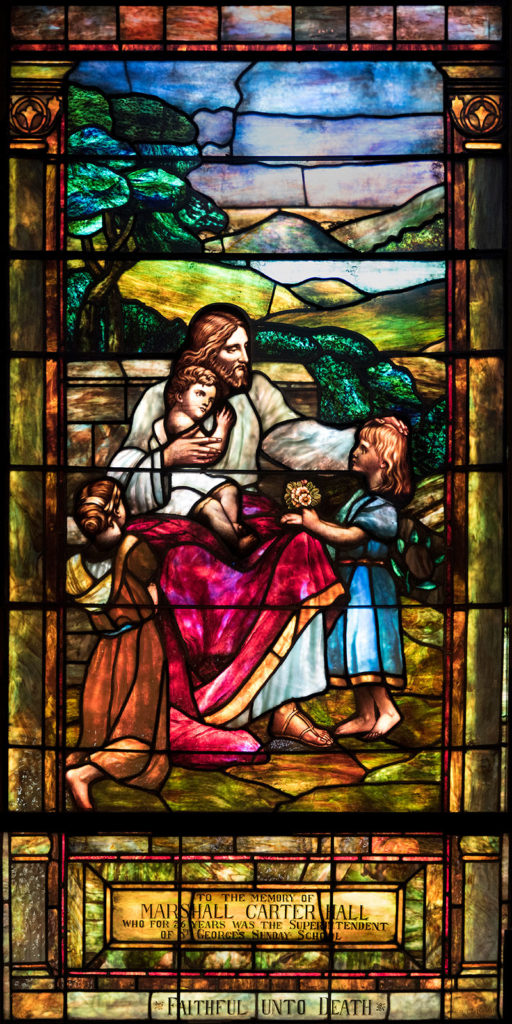
The window was made by the Colgate Art Glass Co in 1907 in memory of Marshall Hall.
Hall (1843-1903) was a Superintendent of Sunday Schools for 38 years. The window was donated by the St. George’s Sunday School. He was a druggist at J.B. Hall Sons on the corner of Caroline Street and Williams Streets, established by his father John Byrd Hall.
There are at least 3 scriptural references linking Jesus with Children in the gospels of Matthew, Mark, and Luke. In Matthew, Jesus said, ” …Suffer little children, and forbid them not, to come unto me: for of such is the kingdom of heaven.”
More information on the Jesus with Children window
N03
Road to Emmaus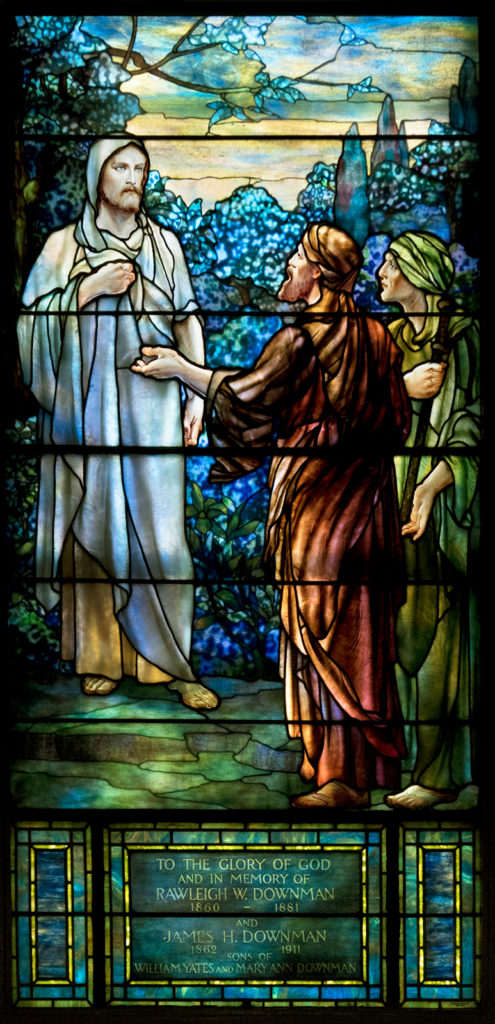
The window was given by Mary Ann Downman, who was 90 years old in 1923, living in the same home that she was married. She was the oldest person in Fredericksburg at the time. The window was given in memory of two sons who predeceased her.
The story of this window is from Luke, chapter 24, verses 13 to 35.
In the image, Cleopas and an unnamed companion encounter the risen Christ on the road to Emmaus about seven miles from Jerusalem. The men are shocked that anyone could have been in Jerusalem and had not known of the events that have happened there. “Abide with us,” they ask the unrecognized stranger, “for it is toward evening, and the day is far spent.” It was not until they offered Him hospitality and He blessed and broke the bread that they recognized Him. He soon disappeared. They got up and returned at once to Jerusalem. There they found the Eleven and those with them, assembled together and saying, “It is true! The Lord has risen and has appeared to Simon.”
The look of incredulity and awe on the faces of the men stands in contrast to the dignity and still expression of Christ. As in most windows by Tiffany Studios, the faces and arms are painted with enamel.
This window shows off Tiffany’s techniques with glass. Drapery glass creates ripples of undulating fabric, as well as areas of shading, realistically depicting the figures’ forms. Plated, Spotted and Confetti glass are used to portray the dappled leaves on the trees in the background. To make confetti glass, small, irregularly shaped pieces of glass are embedded into the reverse side of a sheet of glass.
More information on the Road to Emmaus window
N04
Cross with Lamp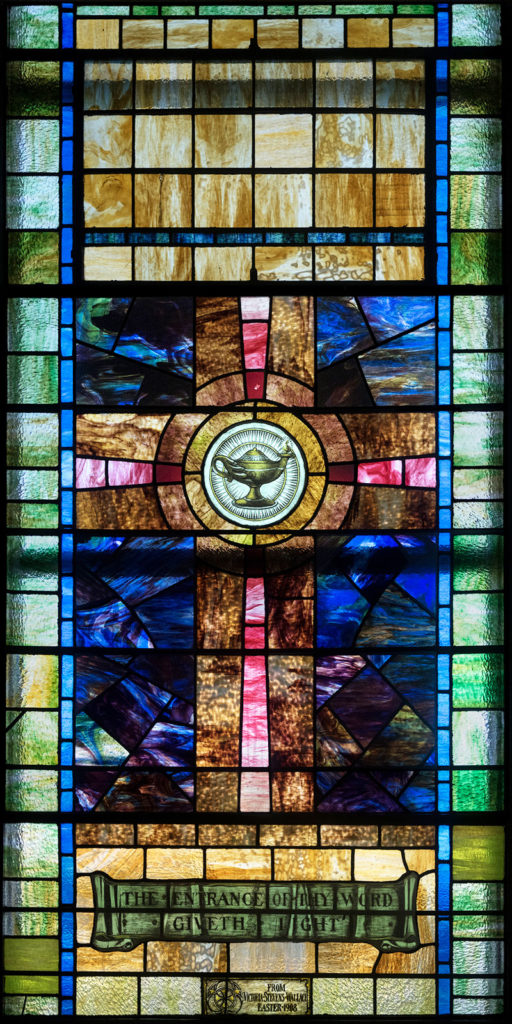
This window was one of those given by Victoria S. Wallace in 1908 and was made by Charles Hogeman. The verse (“The entrance of thy word giveth light…”) comes from Psalm 119:130.
A cross shines forth out of a dark blue background. Different rows are filled with different shapes of stones. In the center of the cross, we find an oil lamp, surrounded by two concentric circles.
The lamp is used as a symbol of wisdom and piety. The Bible describes the Word of God as a lamp unto the faithful. In the parable of the wise and foolish virgins, a lighted lamp is used to indicate the wise ones.
More information on the Cross with Lamp window
N05
Cross with Chi Rho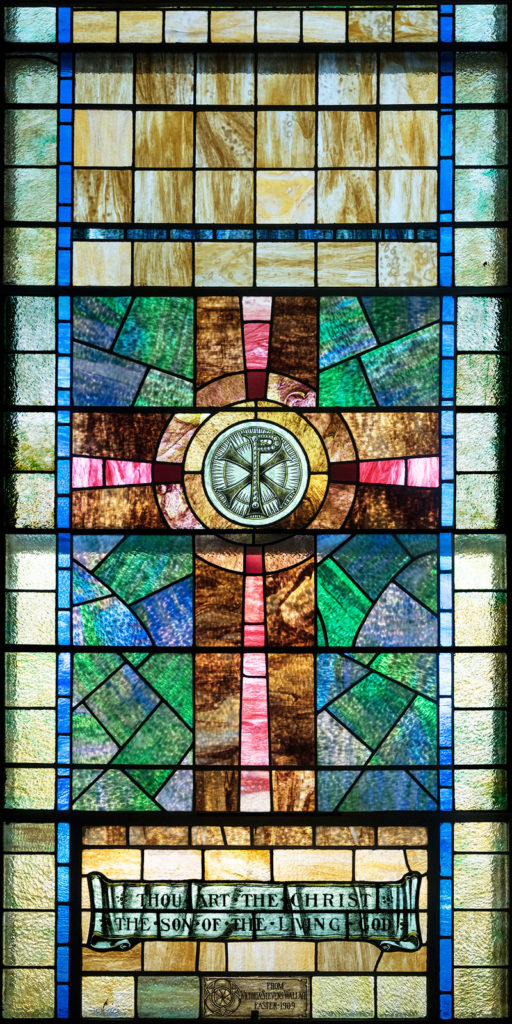
This window was given by Victoria S. Wallace in 1909. She was the wife A. W. Wallace who was a local judge and served as a vestryman here for many years. The window was made by Charles Hogeman. The window’s verse (“…Thou art the Christ, the Son of the living God”) comes from Matthew 16:16. Jesus had taken the disciples out of Galilee, away from the crowds and Herod. There he asked them to confess their faith.
A cross shines forth out of a dark blue and green background. Different rows are filled with different shapes of stones. In the center of the cross, we find a Chi-Rho, surrounded by two concentric circles.
The Chi-Rho is one of the earliest cruciform symbols used by Christians. It is formed by superimposing the first two letters of the word “Christ” in Greek, chi, and rho. Although not technically a cross, the Chi-Rho points to the crucifixion of Jesus. It also symbolizes his status as the Christ.
More information on the Cross with Chi Rho window
N06
Cross with Sun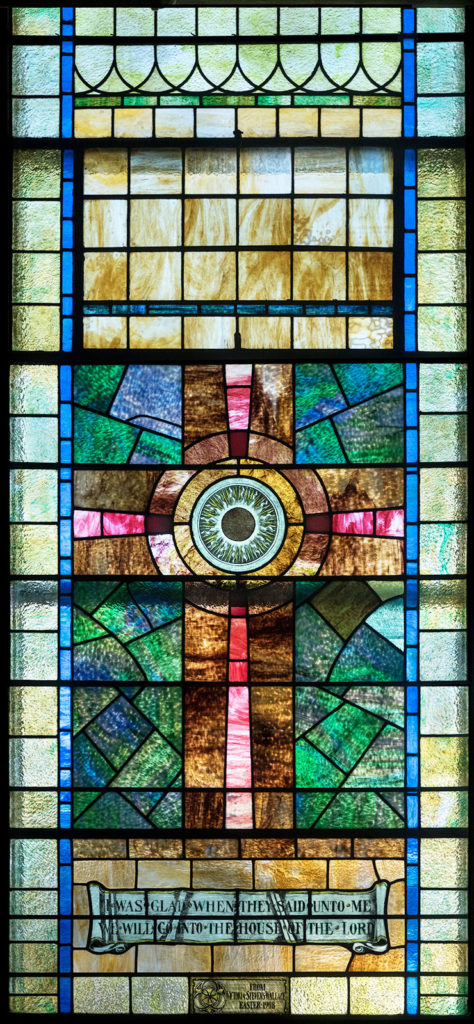
This was one of the windows given by Victoria S. Wallace in 1908. It was made by Charles Hogeman. The verse is from Psalm 122:1.
“I was glad when they said unto me, Let us go into the house of the Lord.” David wrote it for the people to sing at the time when they traveled to the holy feasts in Jerusalem. It appears to be suitable to be sung when the people had entered the gates and their feet stood within the city.
A cross shines forth out of a dark blue and green background. Different rows are filled with different shapes of stones. In the center of the cross, we find a sun, surrounded by two concentric circles.
The sun is symbolic of Christ. It is also a symbol of truth.
More information on the Cross with Sun window
Please proceed to the front of the church for the Ascension window which faces east.
E01, E02, E03
Ascension 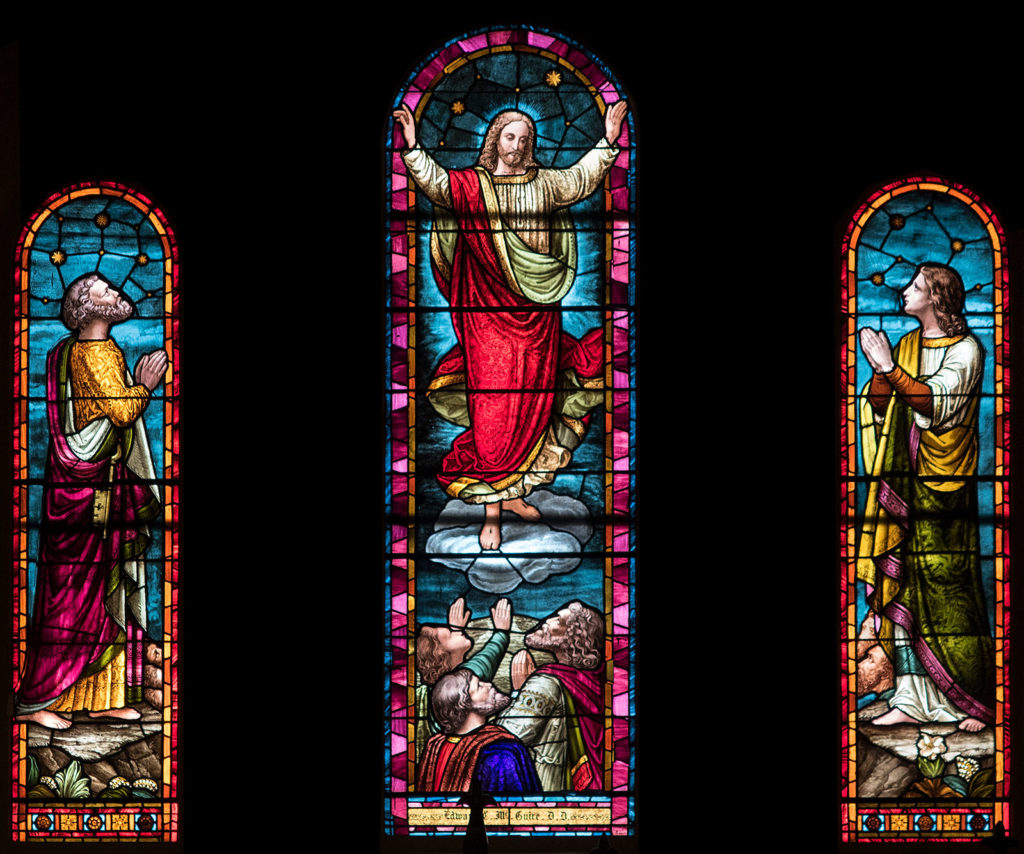
These are the earliest stained glass window in our church. They were installed in 1885 and dedicated to Rev. Edward McGuire who served as rector here for 45 years from 1813-1858. He was, in fact, the rector when the current church was built. This window was produced in Germany, but we do not know the maker.
The Ascension took place 40 days after the Resurrection when Jesus led the disciples to the Mount of Olives. He raised his hands, blessed them and then was lifted up until a cloud took him out of their sight. In the Church of the Ascension on the Mount of Olives, there is an indentation of a rock that is meant to be Jesus’ last footprint on the earth. The rock is partially shown on the left window which depicts St. Peter. Jesus asked the disciples in Matthew chapter 13, ‘But whom say ye that I am?’ and Peter replied ‘Thou art the Christ, the Son of the living God.’ As a result of that declaration, Jesus said in verse 19: ‘…I will give unto thee the keys of the kingdom of heaven…’
The right image is probably that of John, the beloved who was always with him. John is always depicted as a young, smooth-faced disciple. The other 8 disciples are present – three in the bottom right of St. Peter, three in the middle, 2 in the John window. Judas was not there since he had hanged himself and neither was Thomas.
More information on the Ascension window
Please go outside the church through the red doors and face the steeple for the window above the door
W01
Font /Ark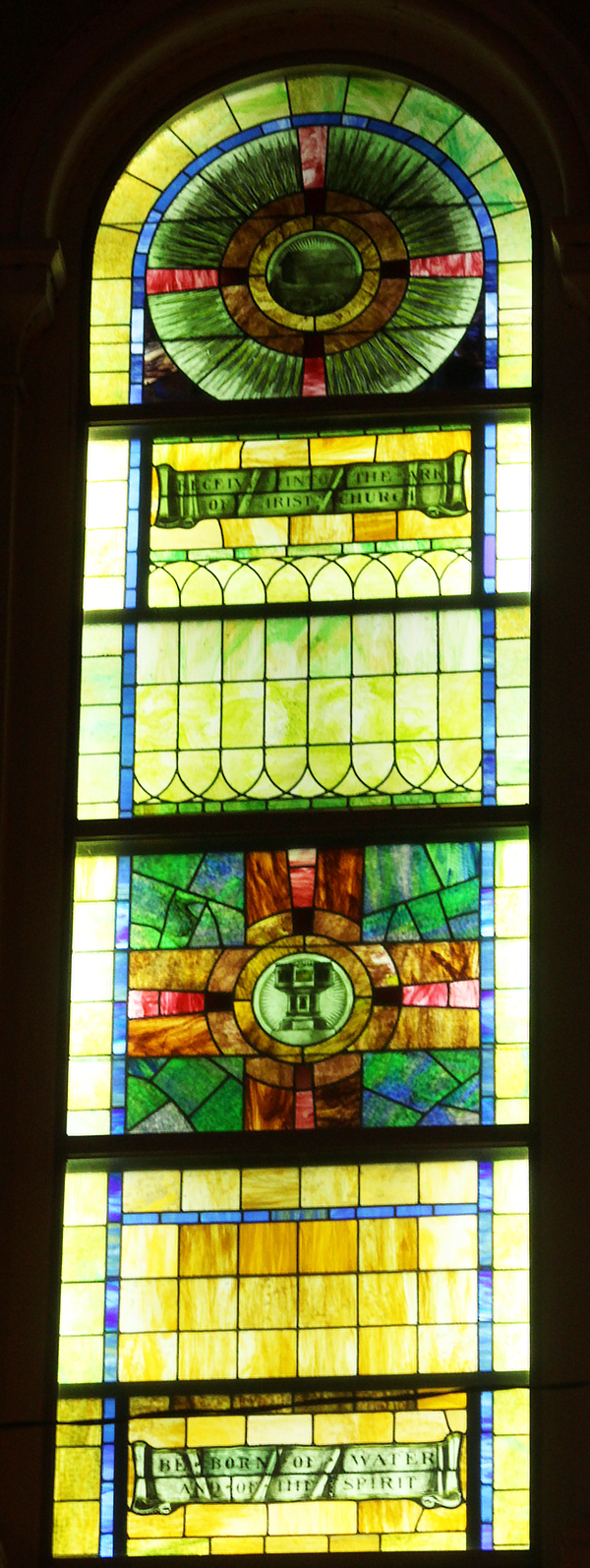
This window is hidden behind the door leading into the Belfry. You can see it from the outside on Princess Anne Street. At night it is lit!
It was one of the windows given by Victoria S. Wallace in 1908 The window was made by Charles Hogeman. The Wallace windows use similar glass around a center symbols arranged in five rows of stone with the central theme in the middle. Surrounding the symbol are two concentric circles of stones. Within each row are different shapes of glass. The effect is traditional without any special treatment of the glass or painting. This is the only window of this type that you can see without the inside gallery dividing the top and bottom.
The Ark window at the top has the inscription, “Be Received Into The Ark Of Christ’s Church,” This verse is from the 1789 Prayer book. The Ark was the sign of God that God would be with man until the establishment of the new covenant.
The font towards the bottom is used during Baptism. Baptism can be performed either by immersion or non-immersion. The verse is from John 3:5, “Truly, truly, I say to you, unless one is born of water and the Spirit, he cannot enter into the kingdom of God.”
More information on the Font window.
More information on the Ark window.
This concludes our summary tour. Thanks for coming along!
We have several other tours for you to take – An in depth tour of the Tiffany windows, the Top 6 windows in our collection, Tour featuring the Stained glass designers, Charles Hogeman’s windows, the Oldest and Newest windows, and finally the Colgate Windows.
You can also choose to review this tour.